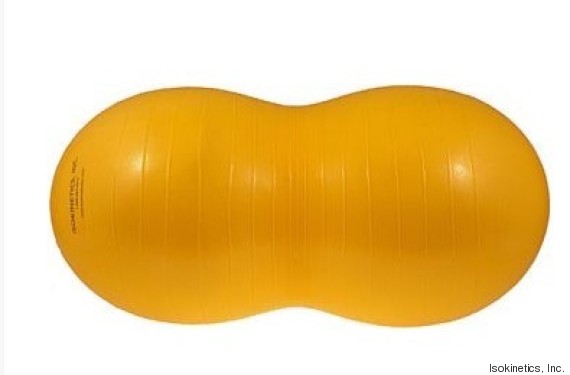|
|
|
Home | Pregnancy Timeline | News Alerts |News Archive Mar 2, 2015

Following an epidural, only 10 percent of women who used the peanut exercise ball
during labor required cesarean surgery, as compared to 21% who did not use the ball
but did have to have cesarean
deliveries. |
|
|
|
|
|
Exercise ball decreases labor time and C-sections
Researchers, who are nurses, have found that a peanut-shaped exercise ball can be a highly effective tool to accelerate labor following an epidural.
Research shows women using the peanut shaped ball during labor were half as likely to undergo a cesarean and delivered babies faster than those who didn't use the ball. These results are published in the 2015 winter edition of the Journal of Perinatal Education.
"The peanut ball is a low-risk, low-cost nursing intervention that promotes positive outcomes and reduces duration of the delivery process," said Christina Tussey, MSN, RN, CNS, lead author of the study and a clinical nurse specialist at Banner Good Samaritan Hospital in Phoenix, Arizona. "Of U.S. women who require a primary cesarean surgery, more than 90 percent will have a repeat cesarean. Women using the peanut ball during labor had a statistically lower rate of cesarean section for delivery — thus reducing risks associated with cesarean surgery in subsequent pregnancies."
Epidurals help relieve pain during birth. They block nerve impulses in the lower spine and decrease sensation in the lower half of the body. But along with size and position of the fetus, epidurals can prolong labor and are associated with an increased need for cesarean surgery or C-sections.
C-sections currently account for more than 30 percent of childbirths nationwide and are often perceived as benign. However, the procedure can increase the risk of infection and hemorrhage for moms while also damaging her abdomen and urinary tract. Undergoing a surgical procedure, women generally experience a longer birth recovery time with possible complications from anesthesia, which can increase health care costs.
The ability to change position during labor often results in decreased labor time as movement can increase circulation thus improve the quality of contractions, increasing fetal descent through the birth canal. But women using an epidural are limited in their ability to change positions in labor as their nerves have been numbed below the waist.
This nurse-led trial conducted at the nonprofit Banner Good Samaritan Hospital in Phoenix, Arizona, examined differences between delivery groups who did and did not use the peanut ball following an epidural. They observed a decreased length of labor and an increased rate of vaginal birth in women who used the peanut ball. Their findings suggest that labor is enhanced by repositioning the fetus through movement on the peanut ball, while at the same time increasing pelvic diameter which allows more room for fetal descent.
Women using the peanut ball had a significantly shorter first and second stages of labor. Of women in the control group, all of whom had an epidural, 21 percent required cesarean surgery — while only 10 percent of those who used the peanut ball during labor needed a C-section.
"Based on the success of the study, we have implemented use of the peanut ball in all labor and delivery units across Banner Health," adds Emily Botsios, BSN, RN, an author of the study and clinical nurse at Banner Health.
Abstract
One strategy for reducing the primary cesarean surgery rate and length of labor is using a peanut-shaped exercise ball for women laboring under epidural analgesia. A randomized, controlled study was conducted to determine whether use of a “peanut ball” decreased length of labor and increased the rate of vaginal birth. Women who used the peanut ball (n = 107) versus those who did not (n = 91) demonstrated shorter first stage labor by 29 min (p = .053) and second stage labor by 11 min (p < .001). The intervention was associated with a significantly lower incidence of cesarean surgery (OR = 0.41, p = .04). The peanut ball is potentially a successful nursing intervention to help progress labor and support vaginal birth for women laboring under epidural analgesia.
About Banner Health
Headquartered in Phoenix, Banner Health is one of the largest, nonprofit health care systems in the country. The system manages 25 acute-care hospitals, Banner Health Network and Banner Medical Group, long-term care centers, outpatient surgery centers and an array of other services including family clinics, home care and hospice services, and a nursing registry. Banner Health operates in seven states: Alaska, Arizona, California, Colorado, Nebraska, Nevada and Wyoming. For more information, visit http://www.bannerhealth.com.
Return to top of page
|
